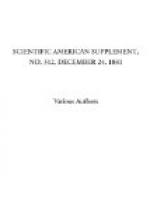The method in common use, and which may be called the natural method, is to devote a separate drawer to the drawings of each machine, or of each group or class of machines. The fundamental idea of this system, and its only one, is, keeping together all drawings relating to the same subject matter.
Every draughtsman is acquainted with its practical working. It is necessary to make the drawing of a machine, and of its separate parts, on sheets of different sizes. The drawer in which all these are kept must be large enough to accommodate the largest sheets. The smaller ones cannot be located in the drawer, and as these find their way to one side or to the back, and several of the smallest lie side by side in one course, any arrangement of the sheets in the drawer is out of the question.
The operation of finding a drawing consists in turning the contents of the drawer all up until it is discovered. In this way the smaller sheets get out of sight or doubled up, and the larger ones are torn. No amount of care can prevent confusion.
Various plans have been adopted in different establishments intended to remedy this state of things, but it is believed that none has been hit upon so convenient, in all respects, as the one now to be presented.
The idea of keeping together drawings relating to the same machine, or of classifying them according to subjects in any way, is entirely abandoned, and in place of these is substituted the plan of keeping together all drawings that are made on sheets of the same size, without regard to the subject of them.
Nine sizes of sheets were settled upon, as sufficient to meet our requirements, and on a sheet that will trim to one of these sizes every drawing must be made. They are distinguished by the first nine letters of the alphabet. Size A is the antiquarian sheet trimmed, and the smaller sizes will cut from this sheet, without waste, as follows:
A, 51x30 in.; B, 37x30 in; C, 25x30
in.; D, 17x30 in.; E 121/2x30
in.; F, 81/2x30 in.; G, 17x15 in.;
H, 81/2x15 in.; I, 14x25 in.
The drawers for the different sizes are made one inch longer and wider than the sheets they are to contain, and are lettered as above. Those of the same size, after the first one, are distinguished by a numeral prefixed to the letter. The back part of each drawer is covered for a width of from six to ten inches, to prevent drawings, and especially tracings, from slipping over at the back.
The introduction of the blue printing process has quite revolutionized the drawing office, so far at least as we are concerned. Our drawings are studies, left in pencil. When we can find nothing more to alter, tracings are made on cloth. These become our originals, and are kept in a fire-proof vault. This system is found admirably adapted to the plan of making a separate drawing for each piece. The whole combined drawing is not generally traced, but the separate pieces are picked out from it. All our working copies are blue prints.




